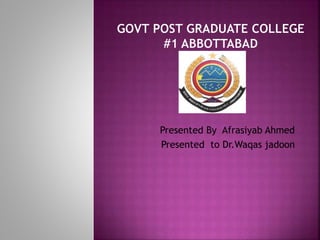
Marine biodiversity
- 1. Presented By Afrasiyab Ahmed Presented to Dr.Waqas jadoon
- 2. The word “Diversity "mean “variation” Definition The variability among the plants form the marine or aquatic ecosystem is called as Marine plant diversity. It includes diversity within species, between species and of an ecosystem
- 3. 5-30 million species are estimated in the world 1.7 million species are nomenclature Which is 13% of the total species (250 years) 1.2 million are animal 0.5 million are plants Every year 15,000 species are discovered
- 4. Oceans occupy 70% of earth Almost 71% biodiversity live in water About 5 million species are lives oceans (unclassified) Over 50% of humans live in the coastal zone Marine plants are few in number it includes algae, sea grasses and see weeds etc
- 5. Marine plants are of two major types Sea grasses and algae Sea grasses are the complex type algae are the simplest type Sea grasses are Algae are Chlorophyta, Rodophyta,Pheophyta etc
- 7. Phytoplankton are the smallest (single celled) plants Diatoms forms glassy microscopic cells forms chains Few marine are angiosperms which are found near the tropical coasts Chlorophyta are the most common type of marine plants About 200,000 algae species are exist While 36,000 have been identified
- 8. Red algae have pigment Phycoerythrin They are largest & diverse They are adhere to the corals thus creating reefs
- 9. Marine plants live near the sea shores, salt marshes and open seas worldwide Gaint kelps found in south pacific in warm coastal water
- 10. It may be found in ice i.e ice algae found live in floating sheets
- 11. Algae may live inside marine animals they may have a symbiotic relationship i.e. between algae and corals Corals secrets enzymes to algae which release carbohydrates while algae to received N2 form corals waste Algae are also shaded from sunlight by coral pigments
- 12. Species have different physical and biological requirments E.g Some algae grows in optimally in sunlight while some prefer low light. It meant that one make a crown while other grow in a shadow of that plant .
- 13. So that there are two ramifications 1- two forms can live without depriving the other needs Together they would more food for others species than form alone This use of complementary use of resources are also called as complementary effect .
- 14. oceans represent 95% of the earth’s biosphere 70% oxygen are produced by marine plants which are regulated in atmosphere As a sources of nutrients i.e DHA Docosahexaaenoic acid found in human milk About 40% of the baby formula are made by these algae
- 15. Algae Duanliella bardawil contains B- carotene which are converted into Vitamin- A by human body Red algae are used in seaweed drinks also use for thickeners for cooking
- 16. Food resources i.e agriculture fish & seafood biomedicals research . Certains Pharmaceutical products are obtain Industries: textiles , buildings materials and cosmetics Tourism and recreations i.e beaches, forests, etc
- 17. The marine environment provides us with Natural beauty (used for recreation) Goods (food, medicine, drugs, energy) Services (e.g. moderation of climate and weather Employment (e.g. fisheries, tourism) Sense of Stewardship/Cultural identity Education on evolution, ecology
- 18. Increasing the human populations out of balance the scale of natural resources Heavy consumptions and exploitation of natural resources Destruction of ecosystem and habitat due to urbanization water Pollution Global climate change Ecological disaster i.e. large scale fire and floods
- 19. It has been estimated that about 17,000 to 100,000 species are eliminated each year In these extinction majority includes plants This happing due to the human activity
- 20. • A Mass Extinction is an event in which very large numbers of species die out in a relatively short period of time • An estimated 34,000 plant and 5,200 animal species - including one in eight of the world's bird species – currently face extinction
- 21. • 1972 United Nations Environment Programme (UNEP) Regional & international agreements to tackle biodiversity issues (e.g. protecting wetlands and regulating trade in endangered species); helped to slow the destruction but have not reversed it
- 22. 1987 World Commission on Environment & Development "Humanity has the ability to make development sustainable-to ensure that it meets needs of the present without compromising the ability of future generations to meet their own needs"
- 23. 1992 Rio Earth Summit-Convention on Biological Diversity Agreement to conserve biological diversity, to use its components in a sustainable way, and to ensure fair and equitable sharing of benefits from the use of genetic resources. Ratified by over 175 countries
- 24. Thank you!
